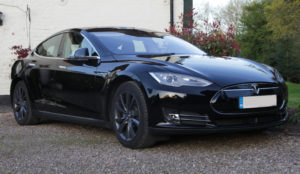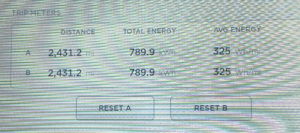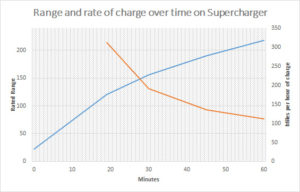Much has been written, said and filmed about the Tesla Model S since its launch in 2012. The continued development of the vehicle is fascinating and with new models due to come out alongside it, all the mainstream automotive model categories will have a Tesla alternative to the Internal Combustion Engine (ICE) powered vehicles of other manufacturers in the next few years.
I’m a self confirmed petrol head and a technology nerd. I’m not an environmentalist. I do however recognise that at some point the fossil fuel supply will dry up to such an extent that ‘Driving for pleasure’ will become cost prohibitive (if in fact it’s not already) and while the future of personal transport may lie in many directions, one that is maturing fast and here now is the Electric Car.
Elon Musk, founder of the Tesla car maker, is a disruptor. He has chosen to disrupt the traditional automotive industry and doesn’t care if he ruffles feathers along the way. To this end there are many reasons why someone like me is attracted to something like the Tesla Model S.
In this first of several posts I will elaborate on how those reasons stack up into an argument for or against Tesla ownership based on my reading, watching and most recently experiencing what it’s like to own a Tesla Model S.
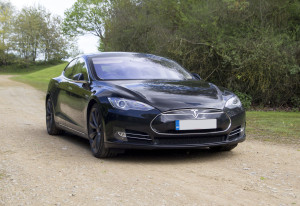
The P85+ I tested
I recently spent 5 days doing an ‘owner experience’. More than just a test drive, I wanted to actually know if the car was as good as it’s supposed to be AND could it be used as a daily driver, in the North of England.
Having spoken at length with the Tesla Sales advisor I hooked up with the team at Eden EV and they supplied me with a 2014 Tesla Model S P85+. For those that don’t know the P is for performance (470hp, 443 lbft, 0-60 4.2s), 85 is the size of battery in KWh and the + means it’s the high spec version , with some toys thrown in. This model is also the Rear wheel drive, single motor variant and the newer versions come in single or dual (all wheel drive) motor variants.
I had a couple of significant questions to answer so let me cover those in this post:
In basic terms is it a ‘Good Car’? Yes. Ignoring the fact that it’s Electric, American and dripping in next Gen technology, essentially this is a good car. It’s easy to drive, comfortable to drive and passenger in and does all the things we expect a luxury sedan to do, reasonably well. In some areas it excels, in some areas it falls behind the likes of Mercedes. I’ll give you some examples. It’s quiet, VERY quiet up to 30mph. After that there’s a reasonable level of wind and tyre noise that you would expect from any vehicle in this class. However, every now and then you notice some things that aren’t what you’d expect from BMW or Mercedes. e.g. in a cross wind, there’s a whistle from either the A pillar or the door mirror and the wipers are noisy. They are also sporadic to react to rain in the auto mode requiring manual ‘flick’ sometimes and other times, turning off. There are other examples which I might cover later but in essence, ignoring the fact that this is a very different vehicle, it’s actually a good car.
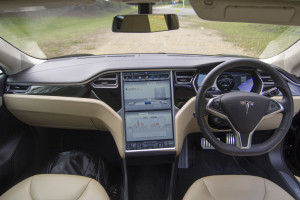
The interior iof the Tesla Model S P85+
Is it easy to drive? This is one I can only answer from my point of view. I’ve had the benefit in having driven well over 500,000 miles in a multitude of vehicles. Petrol, Diesel, Manual, Auto, big, small, old and new. I’ve learned to adapt very quickly to new vehicles and so getting into the Tesla was not daunting at all. The controls are familiar. Column mounted shifter for Park, Drive, N and Reverse. Indicator stalk lifted straight out of a Mercedes and normally weighed brake and throttle. Put the vehicle in drive and with the driver controls set to emulate a normal automatic it’s simply a matter of releasing the foot brake and applying throttle to move forward. Everything is ‘normal’ to drive and I feel that anyone who has driven a modern automatic will feel at home in the Tesla. It’s just a very quiet, very smooth, very responsive incarnation of a modern automatic. The quietness, particularly at low speeds is eerie. Moving cautiously around our works car park was surreal, hearing the tyres squeak as they crossed painted lines but the smoothness and responsiveness of the drivetrain is another world. In no time at all I was able to maneuver the car at super slow speeds, crawling up ramps at much less than walking pace in full and complete control. That micro level of speed control is then transformed at the other end of the scale with a massive shove in the back when you want it. It doesn’t matter what speed, the nature of the electric motor and single speed reduction drive means that full torque is available at all speeds from zero to illegal. More on that later. So, yes, it’s as easy to drive in most conditions as a modern automatic and in some, better.
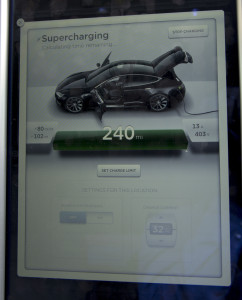
A fully charged battery from a Tesla Supercharger showing potential for 240 miles of range
The third major question is the one everyone wants to know. Is it really feasible in 2015 to own and run an all electric vehicle in the north of England? Yes! Everyone wants to know how far it goes on a charge and where can you charge it? I was determined not to drive it any differently from my current daily driver (A Mercedes 200 Cdi Estate) and see what the effective range was. So, I used the same speed on the motorway, kept up with in town traffic and when the roads were interesting, I used the performance to make progress. So, how far will it go? This model, with me driving, between 200 and 220 miles on a full battery. Where do you get a full battery? Well this is where I flipped my approach. I wanted to see if I could do the full five days driving off the recharge grid and NOT paying for electric. Yes, that’s right. NOT PAYING. I did 800+ miles and didn’t pay for a single mile of fuel. Did I have to plan ahead and change my routes to accomodate? Yes, sure I did but in reality no more than I do with the Mercedes in that I try to fill up with Diesel at my preferred supermarket chain to get me points and keep the cost of motoring down to a minimum. With one exception (through my own choice) I didn’t drive more than a handful of miles off my normal or preferred route in order to charge up. I also did most of my charging at Tesla’s own Superchargers. I didn’t charge up on my own domestic electricity which would’ve cost me but changed the convenience completely. So, even ‘oop north’ there are enough superchargers and EcoCity chargers to facilitate convenience. The downside is the time taken to charge. For every 200 miles you need to charge for between 25mins and 1hr 30 depending on the charging facility used. That requires planning. 20 minutes at a motorway services or hotel with a supercharger is enough for a Coffee but 1.5 hours is a meal stop. Far longer than the 10 minutes you’d stop to put over 600 miles of diesel in the Mercedes but do it overnight or while at work using what is being described as ‘destination chargers*’ and the inconvenience doesn’t just go away, it swings to a benefit over the ICE vehicle.
So, in conclusion, currently owning a Model S in the north of England and using it as your only vehicle is not only possible, but it is, with home charging, as convenient as a normal ICE vehicle. in my next post I will talk about the driving experience in some detail and how this compares to a ‘normal’ car.
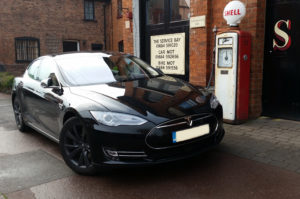 To put that in real terms a Diesel powered car would have to achieve more than 120 mpg to match that price and don’t forget that you don’t have to visit one of those nasty smelly petrol or diesel pumps
To put that in real terms a Diesel powered car would have to achieve more than 120 mpg to match that price and don’t forget that you don’t have to visit one of those nasty smelly petrol or diesel pumps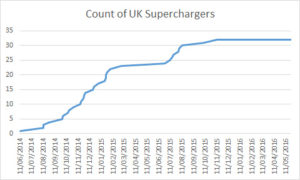 The Tesla Supercharger network is increasing all the time but there has been a notable slow down in the number of new openings recently.
The Tesla Supercharger network is increasing all the time but there has been a notable slow down in the number of new openings recently.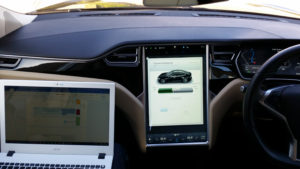 I have queued to use one of the 2 bay chargers but only for a few minutes. I also encountered one Tesla Owner who’s model S was parked on the bay, fully charged for the full duration of my visit (25 minutes). On all occasions I am pleased to report that other owners have been pleasant to chat to if the opportunity arose and a lot of mutual vehicle appreciation. (The same cannot be said for Nissan Leaf owners but that’s a different story). I’ve often used the time taken to charge as an opportunity to use the Tesla as a mobile office.
I have queued to use one of the 2 bay chargers but only for a few minutes. I also encountered one Tesla Owner who’s model S was parked on the bay, fully charged for the full duration of my visit (25 minutes). On all occasions I am pleased to report that other owners have been pleasant to chat to if the opportunity arose and a lot of mutual vehicle appreciation. (The same cannot be said for Nissan Leaf owners but that’s a different story). I’ve often used the time taken to charge as an opportunity to use the Tesla as a mobile office.
